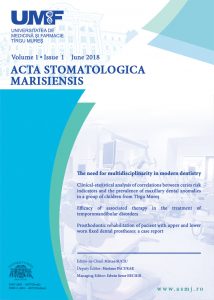Introduction: Pediatric Dentistry offers a completely different approach compared to that of adults especially in terms of patient cooperation, problems with growth and development and problems related to dental restoration in the context of a developing dentition.
Aim of the study: The purpose of this study was to assess the prevalence of primary and secondary dental dystrophies among preschool and school-age children.
Material and Methods: The group of 113 subjects with ages between 3 and 11 years was selected from two primary and preschool education establishments from Târgu-Mures. Simultaneously with the clinical examination of dental surfaces, 150 questionnaires were distributed to the parents of the subjects. The dystrophies determined clinically were arranged in a certain category of number, form, volume and structure and were correlated with the answers to the questionnaires.
Results: According to the data most cases of dental dystrophies are represented by dental fluorosis followed by severe early childhood caries S-ECC, and in equal percentages are present dyschromia, imperfect amelogenesis, MIH hypomineralization, dental fusion, macrodontia and hyperdontia.
Conclusions: There are significant correlations between the primary dental dystrophies and factors that intervened during pregnancy and in the post-natal period, both critical periods for dental formation and development.
Daniela Esian 1, Cristina Bica 1, Ana Petra Lazar 1, Oana Stoica 1
1 George Emil Palade University of Medicine, Pharmacy, Science, and Technology of Targu Mures, Romania
1 George Emil Palade University of Medicine, Pharmacy, Science, and Technology of Targu Mures, Romania

Comments are closed.